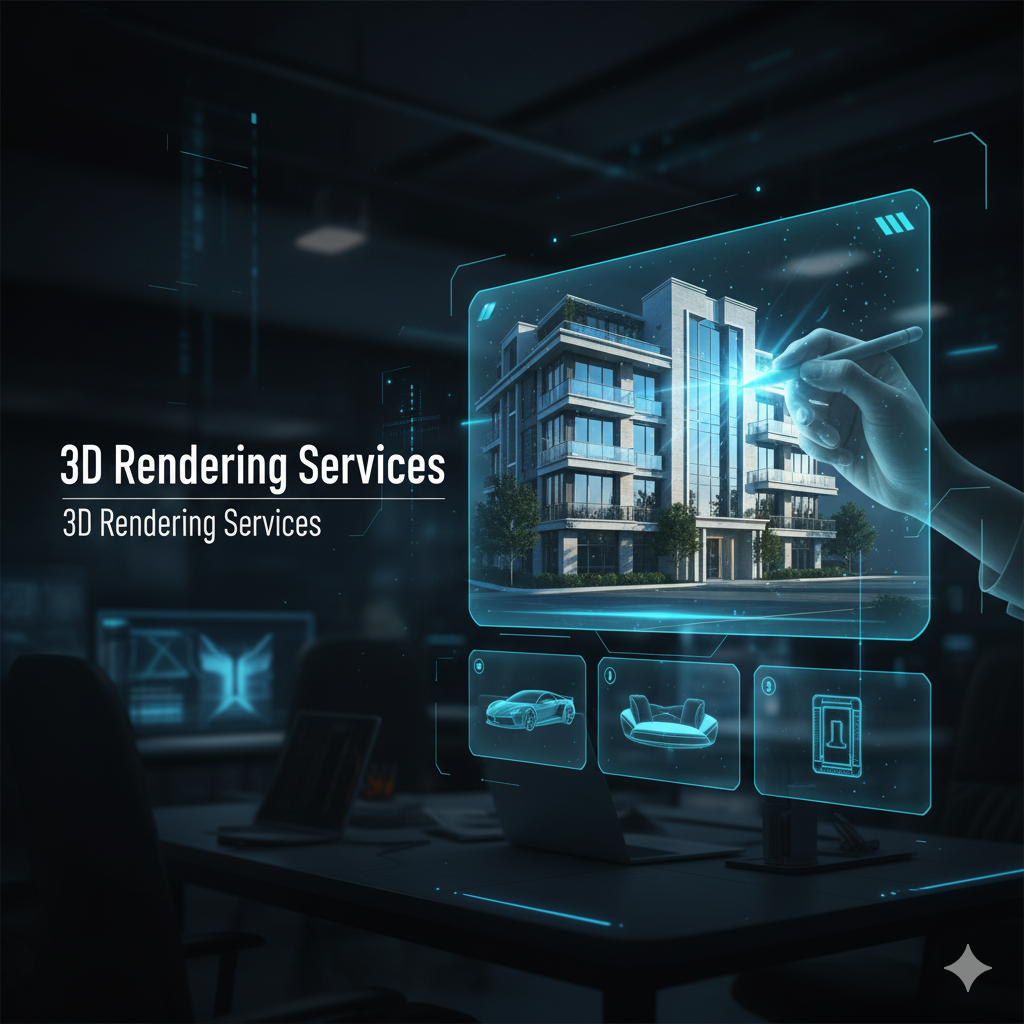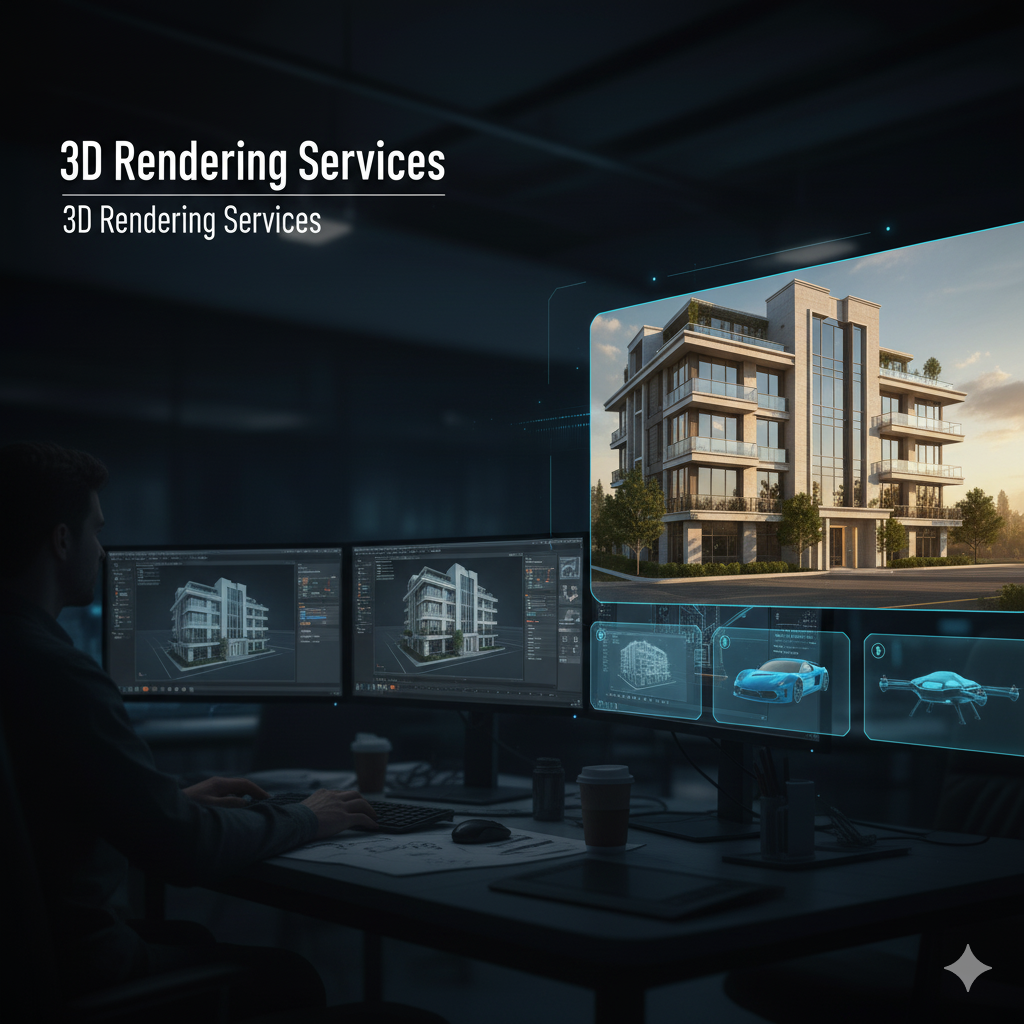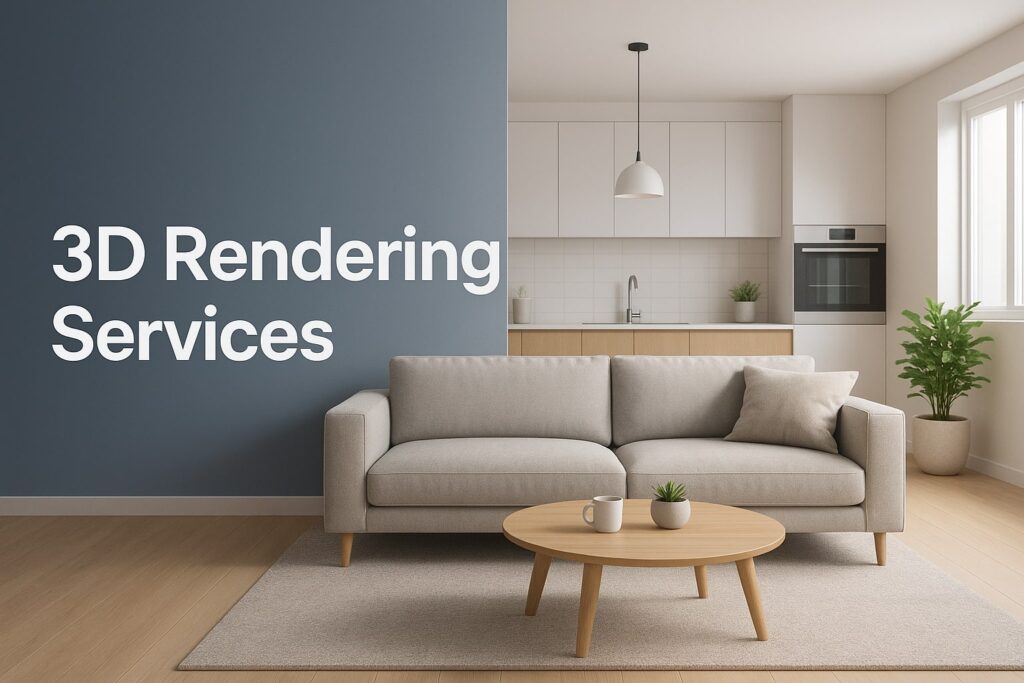OUTSOURCE CREATIVE SERVICES - OUTSOURCE CREATIVE WORKS-OUTSOURCING CREATIVE WORK - OUTSOURCE CREATIVE DESIGN -OUTSOURCE 2D ARTWORKS - 2D ART SERVICES - 2D ART OUTSOURCING -ART OUTSOURCING - OUTSOURCE ILLUSTRATION WORKS - OUTSOURCE ILLUSTRATION SERVICES - OUTSOURCE 3D MODELING - 3D MODEL OUTSOURCING- OUTSOURCING CAD WORKS- OUTSOURCE ARCHITECTURAL SERVICES -BIM - REVIT - 3D FLOOR PLAN - BIM OUTSOURCING SERVICES - MEP - REVIT MODELING - 3D FURNITURE MODELING - 3D ARCHITECTURE MODELING - AUGMENTED REALITY MODEL - VIRTUAL REALITY MODEL - 3D RENDERING - PRODUCT MODELING - 2D SERVICES - OUTSOURCE CREATIVE SERVICES -3D MODELING SERVICES - VFX
Key Trends in 3D Rendering Services Transforming the Design Industry in 2025
The design industry, from 3D Architecture to 3D Product Design, is experiencing a profound technological acceleration driven by advancements in visualization. What was once a slow, resource-intensive process limited to generating static images has evolved into an agile, AI-driven, and fully immersive digital discipline. The future of design is being defined not by what is built, but by how it is first rendered.

In 2025, 3D Rendering is moving beyond photorealism to embrace interactivity, speed, and data intelligence. This shift is not merely cosmetic; it is fundamentally altering design workflows, client collaboration, and market engagement across retail, real estate, and manufacturing.
For professionals and businesses, staying competitive means understanding and leveraging these emerging visualization technologies. This often involves partnering with specialists, a practice that has solidified the trend of Outsource 3D Modeling services. By strategically engaging external expertise, firms can access high-end capabilities like real-time rendering and Augmented Reality - Virtual Reality optimization without the massive internal capital investment.
This guide explores the seven key trends shaping the 3D Modeling and Design landscape in 2025. We will look at how Artificial Intelligence (AI) is democratizing creation, how Texturing and materials are reaching new levels of realism, and how the demand for specialized Outsource 3D Furniture Modeling is redefining e-commerce and interior design.
Trend 1: The AI-Powered Democratization of 3D Rendering and Texturing
The integration of Artificial Intelligence (AI) is arguably the most disruptive force in the 3D industry in 2025, fundamentally speeding up production and making high-quality visualization more accessible.
A. AI in Automation and Optimization
AI is moving beyond simple image generation to become a strategic partner throughout the 3D Modeling and Design workflow, making the practice of Outsource 3D Modeling services more efficient than ever.
- Generative Modeling and Scene Creation: AI tools now take simple text prompts or sketches and instantly generate complex base models or entire realistic environments. This slashes the initial modeling time from weeks to hours, allowing human artists to focus exclusively on refinement, creative direction, and detail work.
- Intelligent Lighting and Composition: Advanced AI algorithms are used to automatically suggest and optimize lighting setups based on the scene's geometry, materials, and desired mood. They can predict how natural light interacts with a 3D Architecture design or how a product's metallic surface should reflect its environment, achieving hyper-realism with minimal manual setup.
- AI-Assisted Denoising: This is a crucial advancement in 3D Rendering. AI algorithms can drastically reduce the noise and grain from high-quality renders in a fraction of the time, allowing artists to achieve production-ready quality faster and reducing computational costs significantly.
B. Procedural Texturing and Material Realism
The fidelity of a render is defined by its materials. AI and procedural techniques have revolutionized the creation of lifelike Texturing.
- Procedural Material Generation: Tools are increasingly leveraging AI to generate complex, photorealistic PBR (Physically Based Rendering) materials. An artist can input a description like "aged, cracked leather with subtle metallic sheen," and the AI creates the necessary maps (Albedo, Normal, Roughness, Metallic) instantly. This eliminates the tedious manual process of photographic texture sourcing or map creation.
- Geometry-Aware Texturing: Advanced algorithms ensure that textures flow realistically over complex 3D models—whether it’s wood grain wrapping a complex cabinet during Outsource 3D Furniture Modeling or stone veneer following the contour of a building façade in 3D Architecture. This automation ensures consistency and technical accuracy that is difficult to achieve manually.
Trend 2: The Shift to Immersive and Interactive Visualization (AR/VR)

The era of static renders is fading; the market now demands interactive, real-time experiences. Augmented Reality - Virtual Reality (AR-VR) is no longer an optional add-on but a standard deliverable.
A. AR/VR Integration for Client Engagement
Immersive technologies are transforming how clients and consumers interact with 3D Product Design and 3D Architecture models.
- Interactive Showrooms and Walkthroughs: For real estate and commercial design, 3D Rendering now powers fully navigable VR tours. Clients can virtually "walk through" a building, change materials in real-time, and experience the scale of the space, improving client understanding and drastically speeding up approval cycles.
- AR for Retail and E-commerce: In retail, AR allows consumers to place a virtual product—like a piece of furniture created through Outsource 3D Furniture Modeling—into their own physical space via their smartphone. This 'Try Before You Buy' experience boosts customer confidence, leading to conversion rate increases of 10-40% and a significant reduction in product returns.
- Specialized Model Optimization: Creating models for Augmented Reality - Virtual Reality requires specific, highly technical skills. Models must be low-poly, correctly scaled, and optimally rigged for real-time engines (like Unity or Unreal). This specialization drives the demand for external partners who focus purely on Outsource 3D Modeling services for immersive formats.
B. The Rise of Real-Time Rendering Engines
Real-time technology (e.g., Unreal Engine, Unity, D5 Render) is bridging the gap between game engine speed and photorealistic quality, replacing hours-long rendering times with instant feedback.
- Faster Iteration: Designers can adjust lighting, composition, or Texturing and see the final result instantaneously. This facilitates a rapid, iterative design process, which is essential when working across global teams or meeting compressed deadlines common in 3D Product Design.
- Live Collaboration: Real-time rendering enables multi-user cloud platforms where architects, designers, and clients can simultaneously interact with the same 3D model, regardless of location, fostering genuine collaboration on 3D Architecture projects.
Trend 3: Specialization and the Strategic Value of Outsourcing
The sheer diversity and complexity of modern 3D Rendering tasks—from technical modeling to final visualization—have made specialization and outsourcing a strategic necessity for competitive firms.
A. The Niche Focus on 3D Furniture Modeling
The furniture and home goods sectors have adopted 3D Rendering wholesale, creating a massive, specialized industry need.
- Catalog Digitization: Manufacturers are replacing costly, slow photo shoots with infinitely customizable 3D models. Outsource 3D Furniture Modeling partners specialize in creating high-poly, photorealistic models that capture intricate details like fabric weave, stitching, and wood grain, suitable for both high-resolution marketing stills and real-time AR apps.
- Virtual Staging: For real estate, 3D artists furnish empty spaces digitally, offering endless staging possibilities without the logistics or cost of physical furniture. The demand for scalable, high-quality virtual furniture assets has made Outsource 3D Furniture Modeling a thriving niche within Outsource 3D Modeling services.
B. Outsourcing as a Scalability and Cost Strategy
Outsource 3D Modeling services has become the primary mechanism for firms to manage fluctuating project volumes and access high-end technology.
- Cost Efficiency: Maintaining an internal team with the latest hardware (high-end GPUs, rendering farms) and software licenses for every niche (Substance Painter for Texturing, 3ds Max for modeling, Unreal for real-time) is prohibitively expensive. Outsourcing converts these fixed, capital-intensive costs into flexible, project-specific operational costs.
- Access to Experts: Outsourcing provides instant access to specialized talent—artists who are experts in creating compliant Augmented Reality - Virtual Reality assets, technical modelers proficient in precise 3D Product Design for manufacturing, or visualization artists specializing solely in cinematic 3D Architecture fly-throughs.
Trend 4: Hyper-Realism, Sustainability, and Data Integration
The final trend focuses on the quality of the visual output and the data it conveys, pushing 3D Rendering toward ultimate fidelity and utility.

A. Beyond Photorealism: The Pursuit of the Perfect Render
Achieving realism is no longer enough; the goal is to make the rendered image indistinguishable from a photograph, requiring mastery of detail and environment.
- Advanced Texturing and Material Shading: The current trend emphasizes imperfection. Renders look real because of subtle wear, fingerprint smudges on glass, or uneven light reflection on aged metal. This highly nuanced approach to Texturing elevates the final quality of all 3D Rendering.
- Environmental and Volumetric Lighting: Modern 3D Rendering places heavy emphasis on accurately simulating atmospheric effects like fog, dust motes, and realistic sun scattering (volumetric lighting). This elevates the emotional impact and believability of 3D Architecture and product scenes.
B. Data-Driven Design and Sustainability
3D Modeling and Design is increasingly used to validate and communicate sustainable choices.
- Green Visualization: 3D Rendering is used to showcase sustainable features in 3D Architecture (solar panels, green roofs, sustainable materials) and 3D Product Design (recycled content, modular assembly). This helps brands communicate their eco-conscious values clearly to stakeholders and consumers.
- Digital Twins and Real-World Data: Models are becoming 'digital twins' that integrate real-world data, such as energy performance metrics or material supply chain information, turning the render into an analytical tool as well as a beautiful image.
Conclusion: The Future is Interactive and Intelligent
The 3D Rendering industry in 2025 is defined by velocity, specialization, and immersion. AI-driven tools streamline Texturing and optimization; real-time engines transform collaboration; and Augmented Reality - Virtual Reality models redefine customer experience. For firms aiming to lead in 3D Architecture, 3D Product Design, or retail, the path to success lies in strategically adopting these technologies. By leveraging expert partners for Outsource 3D Modeling services, especially in specialized fields like Outsource 3D Furniture Modeling, businesses can ensure their 3D Rendering is not just visually stunning, but also a powerful, data-driven tool for competitive advantage.
FAQs:
Q1: What is the biggest technology trend transforming 3D Rendering in 2025?
A1: The biggest trend is the widespread integration of Artificial Intelligence (AI), which automates tasks like lighting optimization, material generation (Texturing), and denoising, dramatically speeding up the 3D Rendering workflow.
Q2: Why is the demand for Outsource 3D Furniture Modeling services increasing?
A2: The demand for Outsource 3D Furniture Modeling is increasing because retailers need high-volume, photorealistic 3D assets to replace costly photo shoots, power e-commerce visualization, and enable immersive experiences like Augmented Reality - Virtual Reality viewing.
Q3: How is AR-VR affecting 3D Product Design workflows?
A3: Augmented Reality - Virtual Reality (AR-VR) is making 3D Product Design more interactive. 3D Modeling and Design must now be highly optimized for real-time performance on mobile devices, allowing customers to virtually "place" products in their space, leading to higher confidence and sales conversion.
Q4: What are the main benefits of using Outsource 3D Modeling services?
A4: The main benefits of Outsource 3D Modeling services are cost efficiency (converting fixed costs to variable), scalability for large projects, and instant access to niche expertise in areas like real-time optimization and hyper-realistic Texturing.
Q5: What is 'Real-Time Rendering' and how does it help 3D Architecture?
A5: Real-Time 3D Rendering allows designers to see the final, photorealistic result of their model instantly as they make changes. For 3D Architecture, this enables faster iteration, immediate client feedback, and interactive virtual walkthroughs without hours of waiting for images to process.
Q6: What does the term '3D Modeling and Design' encompass in the current market?
A6: 3D Modeling and Design encompasses not just the creation of geometry, but also the entire digital process: material creation, Texturing, optimization for various platforms, and the preparation of the model for final 3D Rendering and immersive use.
Visit
Fore more details contact us : https://www.outsource3dmodeling.com/

No comments:
Post a Comment